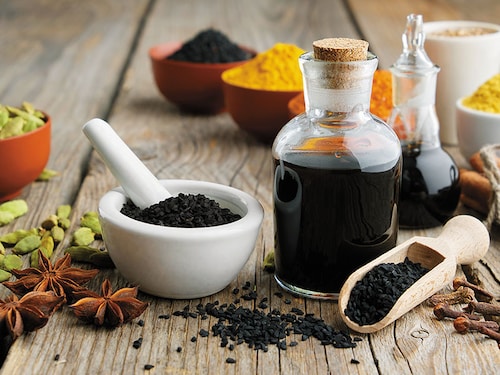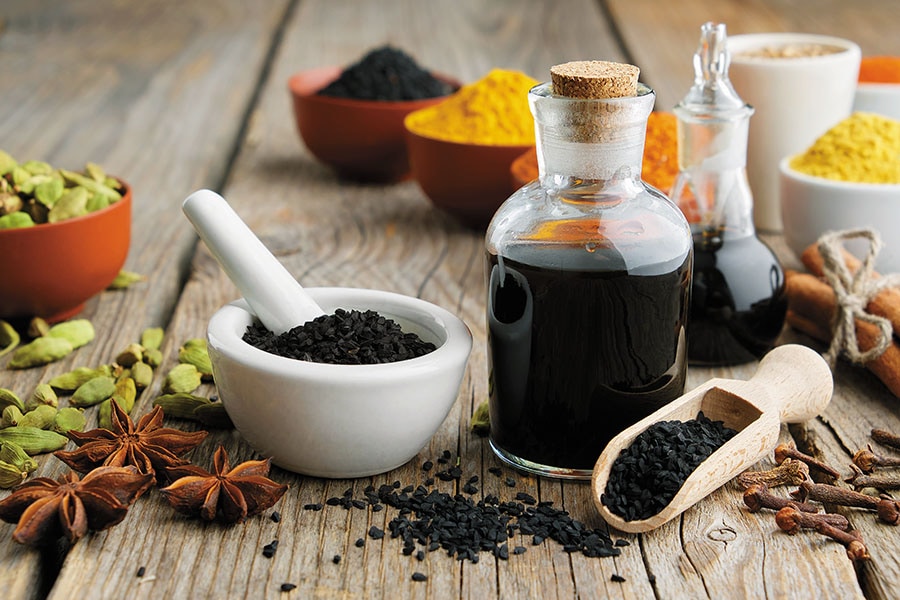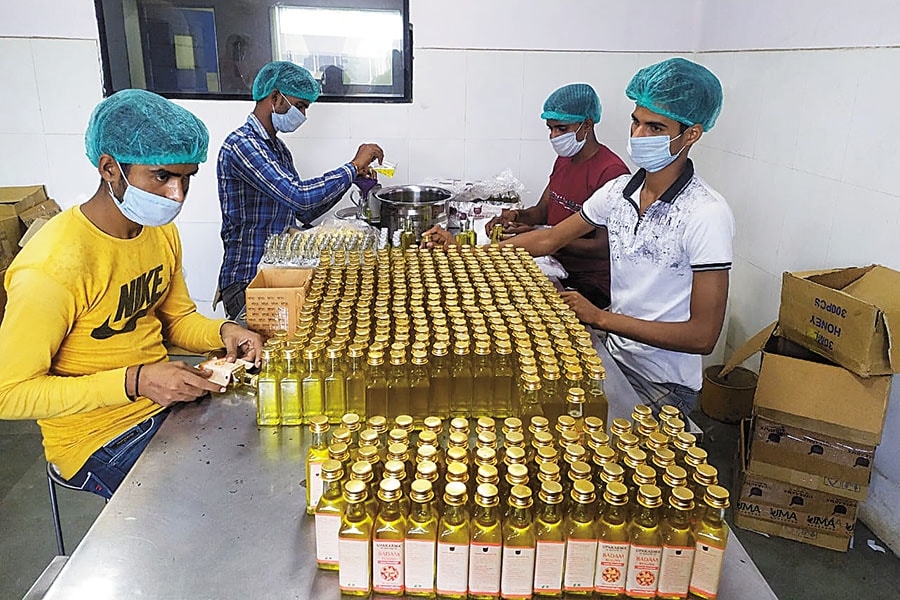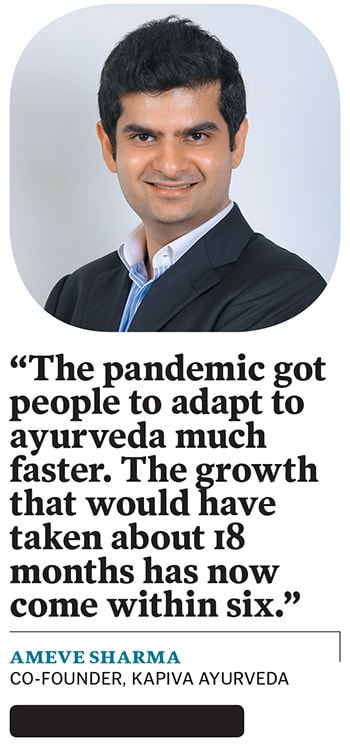Reinventing Ayurveda for Gen-Z
A bunch of young entrepreneurs is reimagining how the ancient wisdom of ayurveda can be made more palatable for newer generations


 Image: Shutterstock
Image: Shutterstock
Deepak Agarwal, who comes from a family of chartered accountants and finance professionals, was the first in his family to become an engineer. He was also a sportsperson, playing football for his college team. “I was the goalkeeper, and we were one up in the match, and it was last few minutes,” he says, recalling one fateful game. That was when an opponent’s knee—instead of making contact with the ball—crashed into his back, breaking two vertebrae. The treatment that followed included allopathy and physiotherapy, but what finally seemed to provide long-term relief was ayurveda and yoga. Consequently, Agarwal also became the first person in his family to turn entrepreneur, when he launched Auric in October 2018.
“I worked with Hindustan Unilever for nine years, and realised that we should be more function- and nutrition-oriented rather than flavour- and taste-oriented about what we consume,” says the founder and CEO of Auric. “Ayurveda is perceived to be either too complex or too boring either ancient and old-school or right-wing. But if ayurveda has to go forward, then it has to be simple and aspirational.” Based on this rationale, Auric launched five kinds of bottled, coconut water-based drinks, which address different aspects of health and well-being. A few glugs from a 250-ml bottle, chilled in your fridge, is enough to give you a portion of your daily dose of ayurvedic goodness.
Like for anything that has survived millennia, evolution has been the key to the relevance of ayurveda. What was once consumed as mixtures of herbs, roots and fruits—fresh or dried—painstakingly ground together in stone mortar-and-pestles, changed form about a century or so ago to evolve as tablets, capsules and bottled liquids. And now, yet again, ayurveda is evolving into more contemporary forms—chewable gummies, powders, shakes and out-of-bottle drinks—in order to be appealing to yet another generation that is seeking holistic well-being in times of turbulence.
Lending a hand to this new phase of evolution is a bunch of young people who aim to make ayurveda not just more approachable, but also better suited to contemporary lifestyles and requirements for consumers between 25 and 40 years.
Like 33-year-old Agarwal, there is 36-year-old Vishal Kaushik, who founded Upakarma Ayurveda in 2017 along with his brother Parag Kaushik (27). “Our father was in the allopathic health care industry. But we chose ayurveda because we found a void in the market space,” says Vishal Kaushik. “There are legendary brands that have their loyal consumers, and then there are luxury brands that are of high quality and price. So we wanted to start an ayurveda brand that is world-class, but available at an affordable rate. Since we are a young brand, we have to create something that will last the next 30 to 40 years.”
Coming from a family entrenched not just in business but in ayurvedic practices as well is Ameve Sharma, president of the Baidyanath Group, which was founded in 1917 in Kolkata. “Ayurveda has never been a medicine for me it has to be integrated into your life,” says Sharma (33). “It includes habits like taking a shot of amla juice every morning. I have seen my father take Ashwagandha once a week. Ayurveda keeps your immunity up, and keeps you healthy. It’s like good nutrition, like eating well.”
But over the decades, says Sharma, ayurveda got influenced by Western forms of medicine, which has a problem-solving approach to health—you pop a pill only when something goes wrong. “Health is not the absence of illness, but the presence of vitality. I felt this was missing in current ayurveda,” says Sharma, who went on to found Kapiva Ayurveda in end-2017, and launched herbal juices in early-2018.
Although part of the Baidyanath family, Sharma chose to start his own venture—agile, and free of the trappings that come with a legacy company—with investments from his father and himself in personal capacities and none from Baidyanath. Sharma has also raised a total of ₹30 crore of external funding, with the largest investor being Fireside Ventures, along with the family offices of Harsh Mariwala and Mohandas Pai.
“When we looked at the current ayurvedic products landscape, we saw two kinds of companies: The traditional businesses like Baidyanath, Zandu, and certain parts of the Dabur portfolio. And then there was the pharmaceutical version, which put ayurveda in capsules,” says Sharma. “But for customers, ayurveda remained something that they could not really understand. But now, with Kapiva’s range of products, they can see what the ingredients really are and what they do.”
*****
Demystifying at least some parts of ayurveda and making it more accessible is one of the ways in which these new brands are winning over a new generation of consumers. Products are sold in forms that can be easily consumed, and carried around, and which taste better. Simple and yet informative labelling helps consumers make more informed choices, while packaging makes them attractive products to pick off the shelf or order online.
Kapiva followed up the launch of its herbal juices with ayurvedic shakes—available as powders, they can be mixed with water or milk to make a drink—and herbal gummies with aloe vera and amla. “We have had a soft-launch of ayurvedic breakfasts, which comprises oats, amaranth, barley, green gram, tulsi, giloy, turmeric, and macro and micro ingredients. It is high in protein and fibre,” says Sharma. “We have also had a soft-launch of an effervescence product that you mix with water and get your full dose of amla or aloe vera.” Upakarma Ayurveda has seen its sales surge by 35 to 40 percent post-Covid-19
Upakarma Ayurveda has seen its sales surge by 35 to 40 percent post-Covid-19
Image: Courtesy Upakarma Ayurveda[br]Tapping into this wellness aspect of ayurveda, Upakarma has launched products such as Ashwagandha for mental wellness, a range of saffron and almond oils for skin and hair care, and beauty products such as serums and shampoos. “When we launched our product range, 50 percent of it was to do with wellness, and 50 percent medicinal,” says Kaushik. “But after the Covid-19 lockdowns started, people were looking for do-it-yourself products and today our wellness products are doing much better.” Consequently, the company launched 12 immunity-boosting products—including juices, Chyawanprash and drops—after the pandemic broke out.
But Upakarma’s best-selling product has been Shilajit, long marketed as an aphrodisiac. Found as a sticky substance formed by the decomposition of plants over centuries in the Himalayan mountains, Shilajit is sold in its pure, resin form by Upakarma. “For years, the packaging of Shilajit products either showed a couple on their honeymoon, or a galloping horse,” laughs Kaushik. “But fact is, shilajit is good for women, for our elderly parents, for our muscles, skin and hormones, and mental health. If you talk honestly to consumers, they will understand.”
*****
It is not just the launch of new products, but the repositioning of existing ones that have helped Zandu Pharmaceutical remain a reliable brand in the ayurveda space. Founded in 1910 in then-Bombay, the brand was acquired by Kolkata-based FMCG major Emami Ltd in 2008 for ₹730 crore. “Zandu is a very strong brand, with 100 years of heritage,” says Harsha V Agarwal, director, Emami. “Over the years, we have tried to understand the expectations of consumers from the perspective of health care, and what they expect from ayurvedic products.”Consequently, about one-and-a-half years ago, Agarwal says, the brand was repositioned as an expert in lifestyle disorders. “Consumer lifestyles are going through a big change, and there are a lot of challenges that they are now facing. There is lack of proper food, lack of sleep, and the lack of exercise routines. They need someone who can provide them with expert products,” he says.
The brand sells between 280 and 300 products, some of them repositioned to address these changes in consumer lifestyles. “For instance, Zandu Pancharishta is positioned as an all-round digestive tonic. Most pills work temporarily, but this tonic works at the fundamental level,” adds Agarwal, while describing the tonic that comprises 35 herbs and cures a range of digestive problems. New products include Immu, immunity-boosting jelly chewables for children, which are available in flavours that they would prefer over the taste of traditional Chyavanprash. In June, Zandu has seen its sales grow by 59 percent over June 2019, with Chyawanprash sales increasing seven-fold.
Talking about the legacy that comes with an established company like Baidyanath, Sharma explains the company has continued to grow because of customer loyalty. “A lot of people turn to ayurveda after they have been failed by allopathy. When they get results, they become staunch supporters.” He adds that over the last few years, Baidyanath’s highest costs have been towards procuring quality raw materials, while spends on marketing and packaging have been very low. “Our biggest strength has always been products. But,” he concedes, “our growth story has not been as big as Dabur’s or Himalaya’s. This is because we never diversified into consumer goods products such as hair care, skin care and baby care. We stuck to our core ayurvedic products.”
In remaining true to its philosophy of manufacturing all the ayurvedic concoctions that have been prescribed in the ancient texts, Baidyanath makes about 1,500 products. And while there are blockbuster products like its Chyawanprash—it holds a 20 percent market share—“about 200 of our products probably don’t make any financial sense at all, in the short term,” says Sharma. “But since it is something we believe in, we will continue to make them.”
With an eye on modernising the company that earns between $100 million and $150 million a year, Baidyanath is now in the process of getting professionals to run the family-owned business. “There will be guidance from senior family members. The idea is to keep our expertise, but also bring in expertise on marketing, communication, and branding to help us reach more customers,” says Sharma.
The diversification and modernisation that Baidyanath aims to achieve took place in the Himalaya Drug Company about 20 years ago. Founded in 1930, it began its journey with herbal products, and became a household name after launching Liv.52 in 1955.
However, it was with the launch of Ayurvedic Concepts in 1999 that Himalaya entered the personal care space with a slew of products such as creams, lotions, face wash, shampoos, pain-relief balms. Today, the company sells close to 500 products, and, according to India Ratings and Research, its revenue increased at a CAGR of 20 percent to ₹28.4 billion over FY12-FY19, “driven by contributions from the recently launched segments and higher sales of its popular personal care and pharmaceutical products”.
*****
Although the ongoing pandemic has put a renewed focus on the need for improving our overall health, ayurveda itself has been thriving over the past years. According to ResearchAndMarkets.com, the ayurveda market in India was valued at ₹300 billion in 2018, and is expected to reach ₹710.87 billion by 2024, expanding at a CAGR of about 16.06 percent.
Its report, Ayurveda Market in India 2019, says one of the key factors in driving this growth is the increasing awareness among consumers to maintain a healthy lifestyle by preferring food products like herbal tea, oats, corn flakes, biscuits, cookies, spices, jam, and almond oil that are made of natural ingredients. “With the increase in awareness about the harmful effects of chemicals on health, used in the production of popular conventional skin care, hair care, body care, and other beauty care products, a shift of preference has been observed in favour of herbal personal care products, which is driving the growth of the market,” the report says.
It adds that Baidyanath, Dabur and Emami together account for about 85 percent of the country’s ayurveda market. However, consumer preference for ayurvedic products is also being reflected in the sales of the new entrants. For instance, Auric sells about 150,000 units every month, with sales doubling after the outbreak, while Upakarma Ayurveda has seen 100 percent year-on-year growth in the three years since its launch post-pandemic, its sales have surged by 35 to 40 percent. Between 2018-19 and 2019-20, Kapiva Ayurveda grew 300 percent, and is on track to grow by another 300 this year.
“There were people who were waking up to the goodness of ayurveda, but the pandemic got them to adapt much faster,” says Sharma of Kapiva. “The growth that would take about 18 months earlier has now come within six. Consumer knowledge levels have gone up, and there are very high repeat purchases.”
Keeping pace with the growth it is experiencing, Auric is planning to launch two more products over the next six months. “We also have the US FDA licence and the UK licence in place,” says Agarwal. “We have shipped our first consignment to the US to test the waters there, and then see what we can do in the UK.”
Upakarma, which is currently valued at ₹70 crore, is looking at expansion at two levels: Geographic, to markets in the US, the UK, and UAE and product, with the launch of four more beauty items.
First Published: Sep 01, 2020, 17:07
Subscribe Now